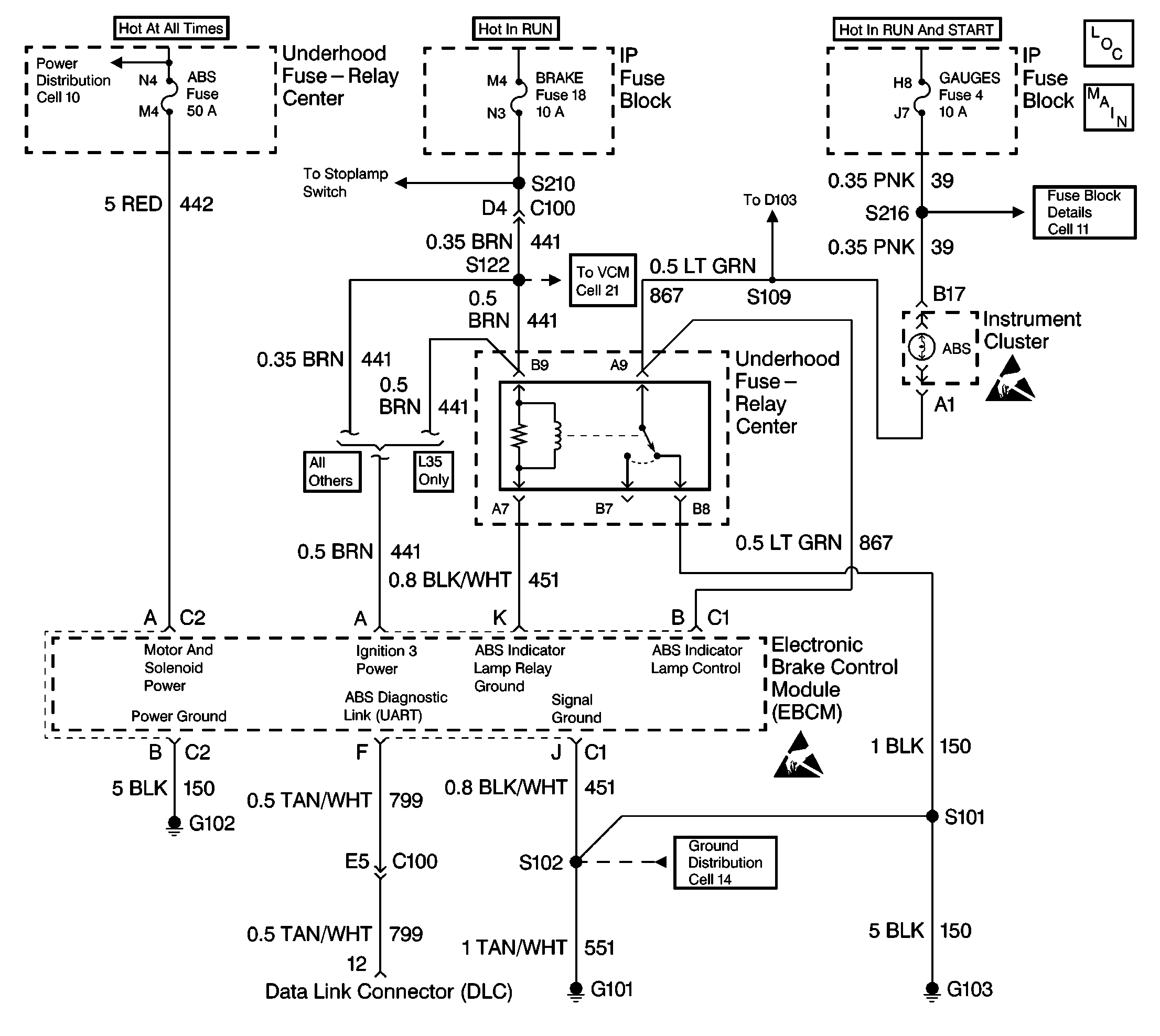
System Description
The diagnostic system check is an organized approach to identifying an Antilock Brake System (ABS) malfunction. The diagnostic system check must be the starting point for any ABS complaint diagnosis. The diagnostic system check directs the service technician to the next logical step in diagnosing the complaint.
Diagnostic serial data is transmitted/received at terminal F (CKT 799) of the 10-way (C1) EBCM connector. The EBCM is supplied switched ignition voltage through terminal A (CKT 441), and ground is provided through terminal J (CKT 451).
Diagnostic Aids
Excessive resistance in the ground or power supply circuits will not allow communication with the EBCM. If communication with the EBCM is not possible, ensure that the ABS ground connection is good and that there is no excessive resistance in any of the power supply circuits.
Test Description
The numbers below refer to the steps in the diagnostic table:
-
This step checks for normal ABS indicator lamp operation.
-
This step checks for ignition voltage at the EBCM.
-
This step checks for high resistance in the ground circuit.
-
This step checks for high resistance in the ignition voltage circuit.
-
This step checks for a short to ground in the ignition voltage circuit.
-
This step decides between a faulty ABS safeguard indicator circuit and ABS indicator off always symptoms.
-
This step checks the electronic brake control lamp relay constant ground circuit.
-
This step decides between a faulty electronic brake control lamp relay and a faulty power/ground circuit to the relay.
-
This step decides between a faulty power or ground circuit to the electronic brake control lamp relay.
-
This step decides between a faulty ground circuit in the EBCM or in CKT 451.
Step | Action | Value(s) | Yes | No |
|---|---|---|---|---|
1 |
Is data being received from the EBCM? | -- | ||
2 | Using the Scan Tool , check for any DTCs. Are any current or history DTCs displayed? | -- | Go to Symptom and Diagnostic Trouble Code Table | |
Did the ABS indicator lamp turn on for three seconds and then turn off? | -- | System is operating normally. Refer to Diagnostic Aids | ||
Is the voltage measured equal to or greater than the specified value? | 10V | |||
Caution: Unless directed otherwise, the ignition and start switch must be in the OFF or LOCK position, and all electrical loads must be OFF before servicing any electrical component. Disconnect the negative battery cable to prevent an electrical spark should a tool or equipment come in contact with an exposed electrical terminal. Failure to follow these precautions may result in personal injury and/or damage to the vehicle or its components. Is the resistance measured within the specified range? | 0-2ohms | |||
6 |
Is the terminal contact or the connection poor? | -- | ||
7 | Replace the terminals or repair the poor connection. Is the repair complete? | -- | -- | |
8 | Reconnect the EBCM connectors and the battery cables. Are the EBCM connectors and the battery cables reconnected? | -- | Refer to Electrical Diagnosis for serial data circuit diagnosis | -- |
Is the resistance measured within the specified range? | 0-2ohms | |||
Is the resistance measurement equal to the specified value? | OL | |||
11 | Observe the ABS indicator lamp. Does the ABS indicator lamp stay on? | -- | Go to | |
Disconnect the 10-way EBCM harness connector. Does the ABS indicator lamp stay on? | -- | Go to | ||
Does the ABS indicator lamp turn on? | -- | |||
Is the voltage measured within the specified range? | 10V | |||
Is the voltage measured within the specified range? | 10V | |||
Is the resistance measured within the range specified in the Value(s) column? | 0-2ohms | |||
17 | Repair open or high resistance in CKT 441. Is the repair complete? | -- | -- | |
18 | Repair open or high resistance in CKT 451. Is the repair complete? | -- | -- | |
19 | Replace the antilock brake indicator relay. Is the repair complete? | -- | -- | |
20 | Repair open or high resistance in CKT 150. Is the repair complete? | -- | -- | |
21 | Repair open or high resistance in CKT 451. Is the repair complete? | -- | -- | |
22 |
Is the repair complete? | -- | -- | |
23 |
Is the repair complete? | -- | -- | |
24 | Inspect CKT 441 and the 10-way EBCM harness connector for physical damage which may result in a short to ground with the 10-way EBCM harness connector connected to the EBCM. Is there evidence of damage? | -- | ||
25 | Repair the terminals which are damaged. Is the repair complete? | -- | -- | |
26 |
Is the repair complete? | -- | -- |
